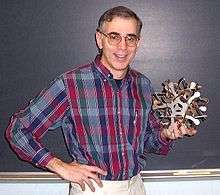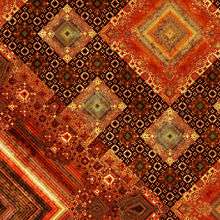George W. Hart
| George W. Hart | |
|---|---|
 Geometer George W. Hart with his "12-part sculpture puzzle" | |
| Born |
George William Hart 1955 (age 60–61) |
| Nationality | American |
| Thesis | Minimum information estimation of structure (1987) |
| Doctoral advisor | Fred C. Schweppe and John N. Tsitsiklis |
|
Website www | |
George William Hart (born 1955[1]) is an American geometer who expresses himself both artistically and academically. He is also an interdepartmental research professor at the State University of New York in Stony Brook, New York.
His artistic work includes sculpture, computer images, toys (e.g. Zome) and puzzles. His sculptures have been featured in articles in The New York Times,[2] Games,[3] Science News,[4] Science,[2] Tiede[2] (Finnish), Ars et Mathesis (Dutch), Наука и жизнь [5] (Russian) and other publications around the world.[2]
His academic work includes the online publication Encyclopedia of Polyhedra, the textbook Multidimensional Analysis, and the instruction book Zome Geometry. He has also published over sixty academic articles.
Hart is a co-founder of North America's only Museum of Mathematics, MoMath, in New York City.[6] As chief of content, he set the "Math is Cool!" tone of the museum and spent five years designing original exhibits and workshop activities for it.
Hart is a coinventor on two US patents, U.S. Patent 4,672,555 Digital ac monitor and U.S. Patent 4,858,141 Non-intrusive appliance monitor apparatus. These patents cover, in part, an improved electrical meter for homes called nonintrusive load monitors. These meters track changes in voltage and current usage by a given household and then deduce which appliances are using how much electricity and when.
Hart received a B.S. in Mathematics from MIT (1977), an M.A. in Linguistics from Indiana University (1979), and a Ph.D. in Electrical Engineering and Computer Science from MIT (1987).
Bibliography
- Multidimensional Analysis: Algebras and Systems for Science and Engineering, 1995, ISBN 978-0-387-94417-3
- Zome Geometry - Hands-on Learning with Zome Models, 2001, ISBN 978-1-55953-385-0
Gallery
-

3D print of a Sierpinski tetrahedron, made of nylon (polyamide) by G.W. Hart
-

Truncated icosahedron (or soccer ball shape), cherry, about 14 inches in diameter, by G.W. Hart
-

Wooden hanging installation in the Barus-Holley building at Brown University in Providence, Rhode Island.
Incompatible Food Triad
The Incompatible Food Triad is a puzzle to find three foods for which any pair will taste good together, but all three together will not. The puzzle is believed to have originated with the philosopher Wilfrid Sellars, and has been spread by some of his former colleagues and students, including Nuel Belnap and George W. Hart. The puzzle was also featured on WNYC's The Brian Lehrer Show.[7]
False solutions
Given three foods that do not go together, it is usually because two of them don't go together. For example, Richard Feynman's famous example of accidentally requesting milk and lemon in his tea is not a solution. While tea and lemon do go together, and tea and milk do go together, milk and lemon do not go together. For this solution to work, milk and lemon would have to go together as well.
According to Hart, most attempted solutions tend to overlook one of the three pairs. Issues of personal taste and preparation complicate the issue, as combinations some consider acceptable sound unpalatable to others, and problems such as milk curdling with the addition of lemon juice can potentially be overcome if a cheesemaking process is employed.
Possible solutions
In a posting on its website after the puzzle was aired on the WNYC radio show in New York; Beer, 7Up, and Whiskey was given as a solution with the statement that beer with 7Up makes shandy, beer with whiskey makes a boilermaker and whiskey with 7Up is a 7 & 7, but the three together would "make you sick". Other possible solutions from viewers included:
- pie crust, raspberries and spinach
- chocolate, peanut butter and chicken[8]
A few of the "classic" solutions are:
- Salted cucumbers, sugar, yogurt.
- Orange juice, gin, tonic.
- Lemon, cocoa, curry.
- Cheese, peanut butter, Jam (AKA:Jelly)
See also
- Conway polyhedron notation - Created propellor and reflect operations for his artwork.
- Vi Hart, George W. Hart's child, a creator of mathematical videos
References
- ↑ "LCCN Permalink for 94039139". Library of Congress Online Catalog. Retrieved 2008-07-20.
- 1 2 3 4 George W. Hart in the News. Consulted on April 5, 2015.
- ↑ http://www.georgehart.com/cite/Games1-readable.jpg
- ↑ http://www.georgehart.com/cite/Ivars-Peterson.pdf
- ↑ http://www.nkj.ru/archive/articles/17807/
- ↑ G. Hart et al., Forming a Museum of Mathematics, in Science Exhibitions: Communication and Evaluation, ISBN 978-0-9561943-8-1
- ↑ The More the Merrier The Brian Lehrer Show (Scott Page guest) April 5, 2007 WNYC
- ↑ PUZZLES! April 5, 2007 Photos and Miscellany from The Brian Lehrer Show WNYC website
External links
- Official website
- Examples of George Hart geometric sculpture
- The Incompatible Food Triad by George W. Hart
- George Hart YouTube channel
